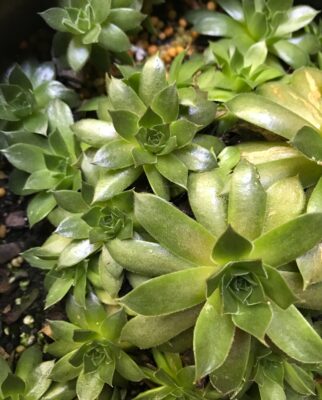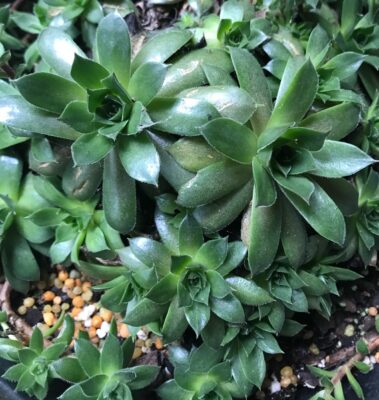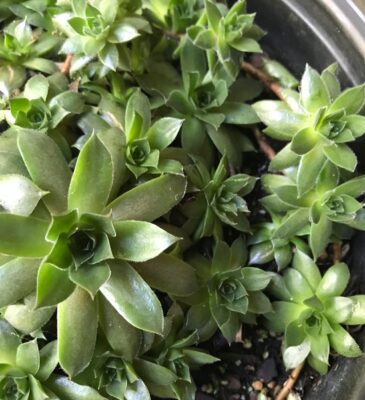This post contains affiliate links.
Hens and Chicks are very popular succulent plants where I live. I often see them growing in rock gardens, in quaint-looking planters such as shoe planters or strawberry pots; I even find them planted at the edges of flower gardens, where they add a nice touch of greenery. I hadn’t ever considered growing them indoors before now since I had always thought of them only as outdoor plants, so I was pleasantly surprised when I looked into growing them as indoor plants and discovered how versatile they really are.
You can easily grow Hens and Chicks indoors, and they can even be grown indoors year-round. They are low-maintenance plants since they don’t require much other than a minimum of 6 hours of indirect sunlight each day, a stable temperature between 60- 80 degrees, and only need watering when their soil is dry.
If you decide to grow your plant indoors, there are a few things you need to keep in mind, so let’s get right into it.

Growing Hens and Chicks Indoors
I love growing outdoors during the spring and summer months when it is warm outside. I’ve grown Hens and chicks before and love how they look in my gardens, but they’ve never survived the cold winters we have here in zone 5b.
I’ve seen many references that they are hardy between zones 3-8, but in my experience, sometimes all it takes is a severe cold snap or two—colder than what we get during a typical winter—and we can lose plants that are normally hardy in our zone.
Since I love how they look and I wasn’t ready to give up on growing these plants, I decided to look into the idea of growing Hens and Chicks indoors so I could enjoy them year-round and I want to share what I learned with you.
- Hens and Chicks plants, Sempervivum tectorum, are also called common houseleeks: They are native to the mountains of southern Europe and are now widely cultivated around the world.
They are very distinctive in appearance. The leaves form around the plant into what is called a rosette. The “hen” rosettes send out runners, and the smaller “chicks” grow off of these runners.
In time, the mother hen is encircled by all her chicks, which is why they are called Hens and Chicks.
- Hens and Chicks Plants are Succulents: Just like other succulents, they don’t tolerate too much water. If their roots are saturated with water for too long, they will start to rot and die. So you should have no problems growing them indoors if you remember that these plants need water only when the soil is completely dry.
Note: Also, remember that the type of soil they are planted in makes a big difference. If you are bringing your outdoor plants inside for the winter, you don’t want to use garden soil since that may stay wet too long and cause problems. It may also bring in insects, which you don’t want!
In this case, you should transplant them into a sandy soil that drains quickly. A cactus and succulent soil mix would work well for this. Amazon has several that can do the trick.
- They Need Lots of Indirect Sunlight: They should be kept in the sunniest part of your home. A south-facing window would likely be the best spot to keep your plants.
If you don’t have enough light in your home, then you should consider supplementing light with a plant light such as this one from Amazon which also happens to double as a stylish tool for highlighting your plants. If you have several plants needing light, then this one might be more convenient and a better choice overall.
- Hens and Chicks Don’t Like Extreme Temperature Fluctuations: Like most indoor plants, you should keep Hens and Chicks away from extreme temperature fluctuations.
That means you should not place them near heating vents, entryways, or even too close to the windows when it’s extremely cold (or hot) outside.

Why Choose Hens and Chicks for Indoor Gardening?
There are several reasons why you should choose hens and chicks for your indoor garden. Not only are they very appealing, but they lend themselves very well to many different types of garden displays. They are low-maintenance, versatile, and can provide year-round beauty in your home garden.
1. Aesthetic Appeal:
They are aesthetically appealing since they feature a central “hen” surrounded by her “chicks” and both the hen and her chicks have striking rosette-shaped leaves. There are many different varieties, and they come in all sorts of colors, making them a perfect choice for creating beautiful displays.
2. Low Maintenance:
They need very little attention; in fact, they thrive on neglect. They only need to be watered when the soil is completely dry. They do, however, need plenty of indirect sunlight which can be supplied by placing them near a south-facing window or by supplementing with a plant light.
3. Resilience:
Hens and Chicks are very hardy and are often grown outdoors year-round in zones 3–8, making them an excellent choice for indoor gardening. You do want to avoid extreme temperature fluctuations just as you would with other succulents. This means you should avoid placing them too near heater vents or cold air drafts.
4. Versatility:
These succulents are versatile, allowing you to get creative with your indoor garden display. They can be grown in all sorts of containers, from traditional clay pots to vertical wall gardens, hanging pots, and even open terrariums. For a couple examples of different types of containers I have used recently, see my article on making Teacup Gardens and this one on Dish Gardens.
5. Year-Round Beauty:
Hens and chicks can maintain their colors and structure year-round when given the proper amount of maintenance (such as light, water, and temperature) and can be a constant source of beauty in your home.

Can You Bring Hens and Chicks Indoors in the Winter?
Hens and Chicks plants are usually hardy up to zones 3–8, but what if you have an especially cold winter?
If your plants are in pots, their roots aren’t protected, and they could die off. One solution is to plant the pots in the ground to better insulate their roots from the cold.
You could also bring your hens and chicks inside for the winter to keep them warm, and they will be fine. They would not only be protected from the harsh cold outside, but they would also add a nice splash of color and greenery to the inside of your home.
You may enjoy growing them indoors so much that they will become a permanent addition to your indoor garden.
This video talks about growing Sempervivum (Hens and Chicks) Indoors.
This post was written for cactus-central.com and is not permitted to be used on other sites.
